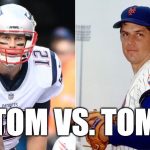Brandon Nimmo Loves Sabermetrics (and So Should You)
 Let’s be honest, most fans have heard of sabermetrics but don’t understand all the gibberish. Perhaps because the word sabermetrics is mentioned on some baseball broadcasts and hardly mentioned on others, few broadcasters discuss how the advanced analytical concepts are affecting baseball.
Let’s be honest, most fans have heard of sabermetrics but don’t understand all the gibberish. Perhaps because the word sabermetrics is mentioned on some baseball broadcasts and hardly mentioned on others, few broadcasters discuss how the advanced analytical concepts are affecting baseball.
I only see so many broadcasts per week, and of all the games I witness on a regular basis—most of the broadcasts are New York Yankees and Mets games, and a smattering of others on MLB, ESPN and FOX—only David Cone on New York Yankees broadcasts periodically discusses sabermetrics, in a somewhat holistic bent. No, he’s not defining each stat, but he discusses the concepts, the way the numbers are affecting the game.
Visible proof of the effect sabermetrics is having on the field are the endless defensive shifts and the way pitchers have changed the focus of their pitches. More pitchers are throwing fewer fastballs and more breaking pitches—the result of analytics that mathematically illustrate that hitters swing and miss more at sliders, curveballs, sinkers and all the other breaking pitches hurled up to the plate.
Of course, the human eye has told the same story for decades, but without the weight of numbers to support strategic change.
If you’ve been watching baseball since the early 1960s, then you’ve seen Sandy Koufax’ devastating curveball dive bomb from from 12 to 6, or Bob Gibson’s one-two combination of blazing fastball up and in followed by a breaking ball on the low-outside corner of the plate, or Steve Carlton’s unhittable slider, or Phil Niekro’s dancing knuckleball. Pitches that made hitters look silly.
It’s no wonder the best pitchers of today, Corey Kluber, Max Scherzer, Jacob de Grom, Chris Sale, Justin Verlander and Aaron Nola (among others), all feature breaking pitches that fall off the table and lure hitters to their doom.
These are the pitchers who will pitch in the postseason. Which is why no team wants to be a wild card if there’s even the slightest possibility of winning their division.
Of course, if you tune into Baseball Now with Brian Kenny on MLB Network, you’ll be barraged with sabermetrica. Broad, non-specific discussions about how important the numbers are. When a concept is alluded to, it’s embedded in a discussion about a player or players with only a cursory reference to the idea. So, while concepts such as “launch angle” and “velocity” only indicate that a ball has been hit hard into the air, the specific statistics which weave these ideas into a core statistic to predict future performance is usually not mentioned.
I’ve never seen Kenny dissect a statistic like wRC+ or wOBA/xwOBA, explain its function, or delve into a discussion to enlighten the audience on the way players are ranked or perform based on statistics like these.(For those readers who don’t know, wOBA combines the outcome of batted balls with walks, strikeouts and hit-by-pitches. xwOBA is a weighted version of wOBA, a future predictor of performance based on how well a hitter is performing today. xwOBA favors players who hit the ball harder and run faster; it expects better future performance from players who have made a lot of outs on hard hit balls. The expectation is that more of those hard-hit balls in the future will fall in for hits.)
It’s true that some sabermetric statistics are mentioned on all broadcasts more often than others, like OPS (on-base plus slugging) and WAR (wins above replacement) in particular. Even OPS+ (the metric of offensive production adjusted for ballpark and era where 100 is average) receives the occasional reference.
Bill Madden of The NY Daily News wrote that the two hottest rookies in the National League this year, Juan Soto of the Washington Nationals and Ronald Acuna of the Atlanta Braves, have surged to an OPS+ of more than 140, and are expected to finish their seasons above 140. “If so, it will be the first time in history two players with 400 plate appearances accomplished that in the same season,” Madden explained.
Now, the question is, if you follow baseball, if you watch NL East games and have seen these two rookies, you don’t need to know their OPS+ to know they are outstanding players who might share the NL Rookie of the Year award, they are that good.
So why OPS+? Because OPS+ can compare player performance not only in a season, but over many seasons. If you look at Adjusted OPS+ at Baseball Reference to compare career OPS+ statistics, the best numbers of all time are those of (1) Babe Ruth at 206, followed by (2) Ted Williams at 190, (4) Lou Gehrig 179, (6) Mike Trout 174, (7) Mickey Mantle 172, (10) Ty Cobb 168, and (19, tied with others) Joey Votto at 156. Only two active players make the top 20. Very interesting.
Or you can see the top 10 players in a season, like the 2018 OPS+ (so far). The biggest surprise according to 2018 Adjusted OPS+ is Brandon Nimmo at 148, third in the National League. His 2018 WAR of 3.8 places him 10th in the NL and his OPS+, is also at 148, placing him 10th in the NL (or 48% above average).
So, these sabermetric statistics reveal a Brandon Nimmo whose standard stats are somewhat ordinary: a .265 batting average with 15 home runs and 39 RBIs, until we find his OPS, which is .890 and tells fans that Nimmo is an above average player the Mets may have failed to utilize properly. Were it not for injuries to Yoennis Cespedes, Nimmo might not even be playing regularly.
So, sabermetrics is a way to splinter baseball data into myriad categories that reveal a different aspect of player performance with each slice of information generated. As we’ve seen, different slices of information integrated together can compose a 3D image of player achievement that might look differently were it only viewed from the conventional baseball categories like batting average, home runs, RBIs and even OBP.
Therefore, a player like Brandon Nimmo, seen under the prism of sabermetrics, is a different player than the one revealed by conventional baseball statistics. But this kind of analysis is still mostly hidden from the ordinary fan.

























